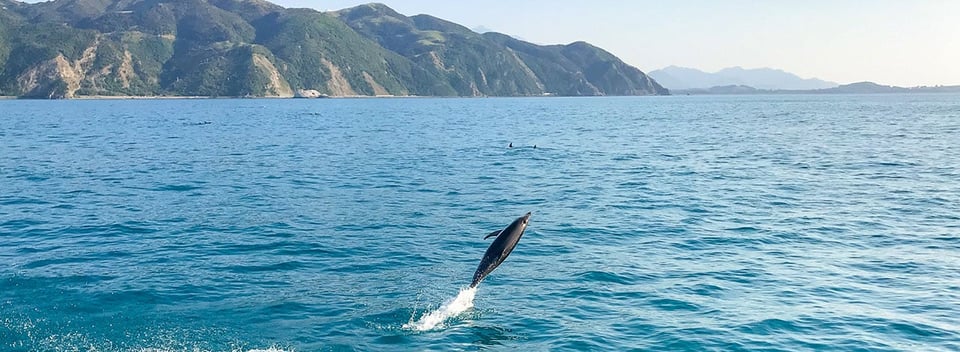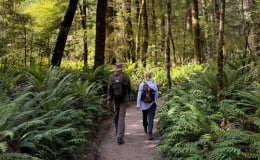
New Zealand Wildlife | Our Top 14 NZ Animals
An introduction to New Zealand wildlife
New Zealand is home to so many species that are found nowhere else on earth! We think that’s pretty awesome and want to share our love of these creatures with the rest of the world. Our endemic critters come in all shapes and sizes, from the smallest dolphin species in the world, Hector’s dolphin, all the way up to a bird that is sadly now extinct, the Haast’s eagle. We’d struggle to fit all of the wildlife in New Zealand on one post; we don’t think you’d even be able to write them on the wing of a Haast’s eagle (their wingspan was an incredible three metres!) so this is just a selection of some of the most curious.
We’ll start with the bird that’s become synonymous with New Zealand, the Kiwi. There’s actually three kinds of Kiwi here in New Zealand, the bird, the fruit and of course, us Kiwis who call these incredible islands home! Our national bird nearly ended up on our flag at one point; you can read more about those shenanigans here.
Kiwi
These wee fellas are found on both the North and South Islands. Kiwi are unable to fly between the islands though as, like many of our birds, these guys are flightless. They call our native forests home and as nocturnal creatures, they can be tricky to find! You’re far more likely to hear them in the wild than see them; the males have a shrill whistle whilst the females have a hoarse cry. These fellas are also pretty excellent at camouflaging themselves. Their brownish-grey plumage allows them to be swallowed up by the colours of the forest floor, but sadly they’re not brilliant at hiding from their biggest threat, man’s best friend.
Kiwi eggs can weigh up to one-quarter of an adult bird’s body mass. To give you some perspective on that number, the average New Zealand woman weighs 72 kilograms / 159 pounds —if she gave birth to a Kiwi-sized baby, it would weigh just over 18 kilograms / 40 pounds as a wee newborn! The Kiwi lays the largest eggs of any bird in the world. We like to do things big here in New Zealand… in fact, we’re home to some of the biggest species in the world.
Kiwi conservation efforts have seen the population grow rapidly in some areas, including around the Coromandel Coast, where the local population doubles each decade. Whilst their numbers are improving in most cases, your best chance to see them is at a wildlife centre. There are heaps of Kiwi encounters across New Zealand, including in Queenstown, Hokitika and Rotorua.
Kea
The cheekiest of all New Zealand birds, Kea are the world’s only alpine parrot. They’re found across the mountainous regions of New Zealand’s South Island, they tend to appear at the same time as food and they also love destroying things! More on that later though as a Kea actually ruined our research notes for this post… Their name came from their call, it’s common to hear a screech of “Keaaaaa” when you’re hiking on the backcountry trails of New Zealand. They possess a colourful cluster of olive-green feathers with a striking scarlet underwing.

If you're in the South Island, and you go walking in the hills, a Kea may pinch your hat!
Kea are thought by many to be the most intelligent bird in the world, with a similar intelligence level to a seven-year-old New Zealander or a 37-year old Australian. We’re only kidding cuzzies (that’s what we call our mates across the Tasman Sea). As incredibly inquisitive creatures, studies carried out by Universities worldwide have shown that they problem-solve as teams and they also exhibited signs of contagious laughter!
They provide locals and visitors with plenty of laughs but they can also be quite frustrating. Like a magpie’s smarter cousin, Kea are fans of taking other folk’s belongings, and their curiosity often leads to the ruination of an array of items, ranging from cars to tents. One of our favourite yarns about Kea is when one of these bright-winged bolshy creatures locked a tramper/hiker in a toilet at a backcountry hut in the Aoraki Mount Cook National Park!
Penguins
You may be surprised to learn that New Zealand is home to more species of penguin than anywhere else on the planet, even Antarctica. These waddling wonders are found along the coastline of both islands, although Blue penguins are the only species that call both islands home. Despite being the smallest of the penguins, this is the species that you are most likely to meet on your Antipodean adventure.
Penguins moult all of their feathers at once. This allows their coats to keep them dry as the moulting prevents leaks in their waterproof insulation. Their most common call at nesting sites is a loud bray finishing with a squeal. Sometimes, low growls can also be heard. Out at sea, penguins channel their inner dog and bark before being told they’re a good boy/girl by their owner (ok, we’re kidding about the last bit!).
Eager to explore the real New Zealand with our expert local guides?
GET YOUR FREE BROCHURE THAT REVEALS EVERYTHING ABOUT OUR ALL-INCLUSIVE TOURS!
This guide to New Zealand includes tour info, itineraries, maps and heaps of photos of our well-established trips!

It’s fair to say that Penguins are some of our favourite characters and we think you’ll feel the same when you get to meet them on your New Zealand trip. There’s a vast array of visual differences between the species, with the yellow-dashed Fiordland Crested penguins and Hoiho (Yellow-eyed penguin) standing out vividly in comparison to the Blue penguins. Most penguin species will remain with their mate for life. They like to stick to their roots, with most penguins returning to the same rookery that they were born at! Like a boomerang, just when the parent penguins think they get a break, their offspring returns to the nest.
Dolphins
Dolphins are a frequent sight around the coast of New Zealand. With their incredibly playful natures, they love to perform in front of a crowd! We’re very proud that the world’s smallest species of dolphin, the Hector’s dolphin, calls our shores home. These tiny triumphs rarely grow more than 1.5 metres in length. They are recognisable by their distinctive rounded black dorsal fins. You can see these cute creatures on our Pure South trip!

One of our guests saying hello to a dolphin.
Like much of the wildlife in New Zealand, dolphins have impressive levels of intelligence. Scientists believe dolphins give themselves names through each dolphin having its own unique whistle. These whistles are used by the dolphins throughout their lives and determine who’s who, helping them to organise the huge social events that dolphins love to be a part of. Dolphins are incredibly communal creatures and live in groups known as pods. On occasion, several pods can merge and form a super-pod of around 1,000 dolphins.
There are six species of dolphin that reside in New Zealand waters. Dusky dolphins are found throughout our oceans but are most likely to be spotted in and around Kaikoura, New Zealand’s marine wildlife hub. You can swim there with these curious creatures on our Masterpiece and Kiwi Classic trips. Swimming with these majestic mammals is an unforgettable experience. There’s something so joyful about watching humans trying to attract the attention of a dolphin with clicking sounds and singing as they glide past.
Seals
Commonly known as the ‘dogs of the sea’, seals can be spotted in and around much of New Zealand’s coastline. A success story of New Zealand wildlife, the population of the New Zealand fur seal continues to increase. Seals have a dark grey-brown coat with two layers of fur that effectively insulates them.

A seal pup looking for a sunbathing spot!
Seals can sleep pretty much anywhere, including underwater. They’re champions at holding their breath underwater too, with some seals able to do so for two hours. Diving is another of their skills with many of the dives being greater than 100 metres in depth with some diving even deeper than 240 metres!
Some of our favourite seal-watching spots include the seal colony at Cape Foulwind on the West Coast and Milford Sound in the South Island. The seals just love to chill in the place that Rudyard Kipling described as “the eighth wonder of the world!”. It’s often joked that you can smell seals before you see them. It’s not uncommon to hear them first too; they can be noisy critters! Females make noise to find their pup upon their return from a foraging trip whilst males use vocalisations during threat displays.
Whales
Earth’s largest mammals reside in the seas around New Zealand. There are four species found in and around the country: Blue whales, Humpback whales, Southern right whales/Tohorā and Sperm whales. Each species has a unique song. Blue whales have the loudest call, whilst Humpback whales have the lengthiest and most complex songs. Did you know that the melody of a Humpback whale can last up to 30 minutes and span seven octaves? That’s nearly the entire range of a piano!
The Southern right whales/Tohorā are distinctive due to their strongly arched mouth, absence of a dorsal fin and V-shaped blowhole spray. They can grow up to 18 metres in length, meaning they are similar in size to the Sperm whale. Sperm whales are easier to spot than the Tohorā as their angled, powerful blows identify them. Humpback whales are relatively easy to identify due to small dorsal fins with a distinctive hump at the front whilst Blue whales are characterised by their blue-grey mottled skin and their sheer size; they can reach up to 30 metres in length.
One of the best places to see these giants of New Zealand wildlife is in Kaikoura. Kaikoura offers an unparalleled, world-renowned opportunity to see marine creatures up close in their natural environment. This is because of the unique conditions found here on the northeast coast of the South Island. A deep continental shelf populated with several underwater canyons combined with a warm current from the north meets a cool current coming up from the south, unlocking nutrients from extreme depths. Both our Kiwi Classic and Masterpiece trips take in this marine life mecca!
Moa
Sadly, the Moa is now extinct due to a combination of factors including overhunting by native tribes. The Giant Moa, found on the South Island, may have been the tallest birds ever found on earth. They reached up to four metres in height and could weigh in at an astounding 250 kilograms/550 pounds. You wouldn’t want to have your foot trodden on by one of these fellows!
It’s believed that they went extinct around 600 years ago, but their impact on the flora and fauna of New Zealand can still be seen today. Trees such as the Lancewood evolved and adapted to the Moa, with the juvenile Lancewood tree growing spiky leaves to protect itself. These leaves then drop off once the tree has grown to a height that the Moa could not reach!
Recently, a local man from Otago found the first-ever Moa footprints on the South Island. This is an exciting advancement in research efforts to learn more about the magnificent Moa. There are plenty of locations where it’s easy to imagine Moa meandering through our native forests. One of our favourite spots to visualise them is in Paparoa National Park on the West Coast. Despite being New Zealand’s smallest National Park, this is a must-see for its Jurassic Park-esque feel!
Haast’s eagle
Another of our now extinct endemic birds is the Haast’s eagle. It is believed to have been the largest and heaviest eagle known to humanity. It could weigh an impressive 18 kilograms/40 pounds and possessed a wingspan of up to three metres. Like the Moa, despite surviving several periods of glaciation, Haast’s eagle is suspected to have become extinct around the same time as the Moa. The Moa was one of their primary food sources leaving them with slim pickings after the flightless bird disappeared.
Maori narratives from the late 1800s record that the giant bird had red, black and white plumage and there were an estimated 3,000-4,500 breeding pairs. As well as eating Moa, they dined on goose and larger rail and duck species found on New Zealand’s South Island. They were also reported to have stolen children on occasion!
Kākāpō
The Kākāpō is one of the stalwarts of wildlife in New Zealand in our humble opinion! Unfortunately, there are less than 200 of these endemic extroverts left, but huge conservation efforts are in effect to increase their numbers. These gregarious green parrots have a cute, owl-like face and an almost penguin-esque waddle.
They are the world’s only flightless parrot. They make up for their lack of flight with their surprisingly effective climbing skills. They are perhaps the longest-living bird species in the world with some reaching the grand old age of 90. Just one more decade and they’d receive a letter from the Queen! They’re big fans of the Proclaimers; during the breeding season, male Kākāpō can walk up to four miles to reach a special arena where they compete with each other for the attention of the fairer sex. After digging a hole in the ground to amplify the sound of his mating call, the male then emits loud, low-frequency “booms” that can be heard up to three miles away.
Kākāpō currently live on predator-free offshore islands and there are plans to bring them back to the Rakiura National Park on Stewart Island in the not-too-distant future. There are many notable Kākāpō that remain. Sirocco is arguably the most famous of his kind, as well as being New Zealand’s official spokesbird for conservation, he has been described as the Brad Pitt of the parrot world! He shot to fame in 2009 when he got overly well-acquainted with a BBC zoologist.
Wētā
Chris and two new New Zealand wildlife friends: a gecko on the left, and a weta on the right.
A veteran within the world of New Zealand wildlife, Wētā are seriously hardy insects! These invertebrates have been around long enough to see the decay of the dinosaurs. There are more than 70 species of these creepy crawlies and they can live in a variety of habitats including grassland, forests, shrubland and caves. They’re easily recognisable with their curved tusks and spindly legs.
Wētā tend to be herbivorous in the wild, but are also known to eat insects. They are capable of a sharp bite and aren’t shy about using their tusks when they’re disturbed by humans. One of the best places to see Wētā in New Zealand is on Mou Waho, one of four islands found on Lake Wanaka. Here, local children have constructed Wētā motels to help protect the insect from predators and keep them dry and toasty!
Their influence is felt in New Zealand’s culture with the special effects studio responsible for films including the Lord of the Rings trilogy named after these tough insects. Weta Workshop is situated in our capital city, Wellington, and the company has been involved in many awesome projects including exhibitions at our National Museum, Te Papa.
Bats/Pekapeka
New Zealand’s only native land mammal, there are two types of bat found on our islands; the long-tailed bat and the short-tailed bat. Both species’ bodies are about the size of a thumb with their wingspan reaching around 30 centimetres. It’s unknown how long the lifespan of a Pekapeka is but it is thought that it could be up to 30 years.
Despite their small stature, these bats are flying machines! They can easily travel 50 kilometres/31 miles in just one evening. This journey is quite effortless for them as they can travel at speeds of up to 60 kilometres or 37 miles an hour.
Like much of the wildlife in New Zealand, the Pekapeka had few native threats which led to the short-tailed variant foraging on the forest floor. Unlike most bat species found on earth, these little chaps fly down to the ground to enjoy a smorgasbord of scrub snacks. They’re found throughout New Zealand and the best time to see them is at dusk.
Fantail/Pīwakawaka

Fantails are steadfast hiking companions!
Fantails are another success story of endemic wildlife in New Zealand. They have effectively adapted to an environment that has seen enormous change brought about by human activity. Whilst they used to predominantly live in native forests and scrub, they are now found in gardens, orchards and more exotic plantation forests too. You’ll likely see a flash of their black and white tails as you meander through both native forest and parkland.
They usually have a grey head, prominent white eyebrows, a mustard under-belly, brown plumage and their distinctive black and white tails. However, there is a much rarer black fantail that has no white hairs at all on their tails. These black fantails are believed to make up less than 5% of the Pīwakawaka population on the South Island. They’re known to get quite close to humans and will often chirp a cheerful song as they approach.
In Māori narratives, the fantail was responsible for the presence of death in the world. Maui believed he could eliminate death by successfully passing through the goddess of death, Hine-nui-te-pō. He tried to enter the goddess’s sleeping body through the pathway of birth. The Pīwakawaka was warned by Maui to be quiet, but instead, the bird began to laugh. This awoke Hine-nui-te-pō, who was so furious that she killed Maui. Māori people believe a fantail in the family home to be a bad omen.
Tui
Yet another of our endemic birds, Tui are found throughout New Zealand. These boisterous birds are often heard before they’re seen. When spotted, they are a sight to behold. They display a rich blue, green and bronze iridescent sheen and have little white tufts that look a bit like Father Christmas’ beard on their throats!

One of the most beautiful New Zealand birds - a Tui having a snack.
Tui are treasured by New Zealanders and many try to lure them into the garden with bird feed and sugar water during the winter months. They are prime pollinators for many of our native plants and trees and they mainly dine on nectar fruit and small insects.
As we’ve already alluded to, these New Zealand birds have a reputation for being raucous residents! They have an unusual call with some notes registering too high for the human ear to hear. They’re not shy and possess two voice boxes, enabling them to perform a wide array of vocalisations. They’ve been known to mimic other birds, and to even impersonate human speech! Tui are also great mimics and Māori prized them for their ability to imitate things, keeping them in cages to welcome people onto the marae (the hub of the Māori community).
Tuatara
We thought we’d save one of the best till last. The only reptile listed here in our insight into New Zealand wildlife, Tuatara are the last survivors of a type of reptile that thrived during the age of the dinosaurs. All species except the Tuatara declined and eventually became extinct about 60 million years ago, meaning that the Tuatara has been around for almost 200 million years! These unique creatures can grow up to half a metre in length and the males showcase a distinctive crest of spines down their backs which are used to attract females and to assert dominance over other males.
Much like humans and our haircuts, these guys can change colour over their lifetime and they shed their skin on an annual basis. In their youth, Tuatara have a third eye which is covered over after adolescence. They used to roam freely on both islands but now only live on several offshore islands, on mainland islands where predators have been eliminated and within conservation centres.
Munching on invertebrates is one of their go-to activities. Considering they can live for up to a century, they have plenty of time to find out what their favourite meal is. They truly are unique and unusual creatures. Unlike most reptiles, they love a cooler climate and can live in environments with temperatures below five degrees centigrade. There’s no chance of these guys spending time on holiday relaxing by the pool!
Round-up
And there you have it. We’ve shared 14 of our favourite residents of New Zealand. Whether you want to experience an abundance of marine life, a cornucopia of bird song or see some of our truly eccentric creatures, New Zealand has them all covered! Whilst we have a host of quirky wildlife in New Zealand, most of them aren't dangerous. Did you know that there are no snakes in New Zealand? We feel pretty fortunate to not have to interact with these occasionally dangerous reptiles, we’ll leave it to the experts across the Tasman in Australia!
If you’d like to learn more about New Zealand’s wildlife or get up close and personal with some of our favourites, then please get in touch to discuss the trip options with our experts.








